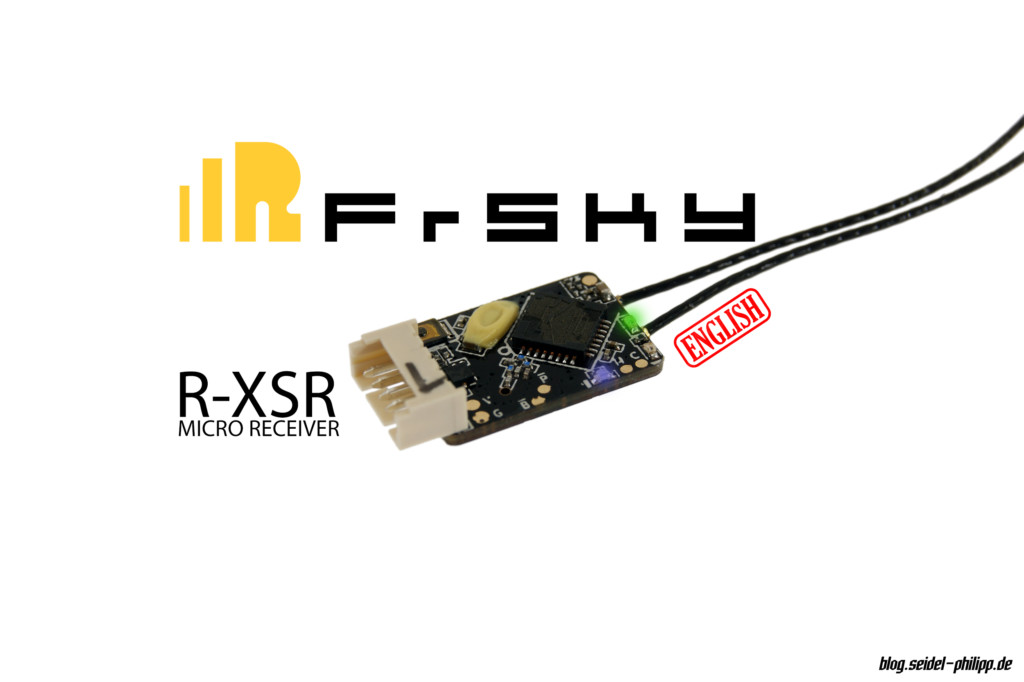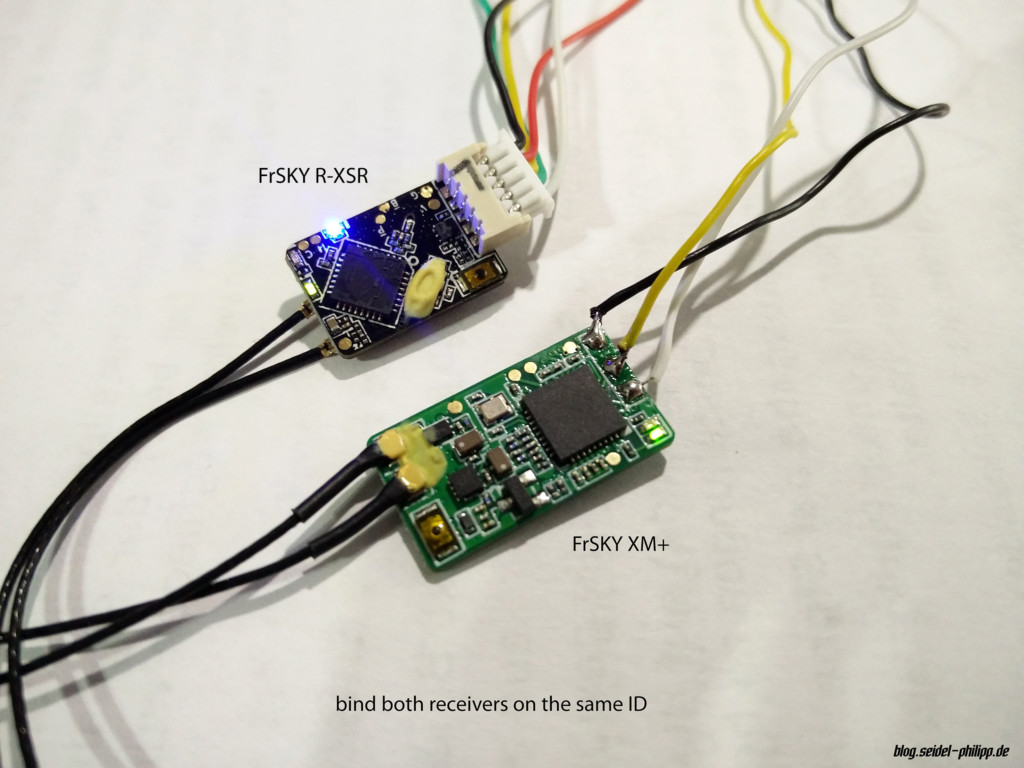FrSky R-XSR – smallest full range receiver with telemetry
The FrSKY R-XSR is a new small receiver with which has the same functions as an ordinary XSR and is supposed to be „full range“. New is the redundancy function. The R-XSR receivers were sponsored to me by the online shop www.premium-modellbau.de. In the new FPV Area you will find more interesting products for FPV Racing.
Inhaltsverzeichnis
Where to buy
Supply source EU (LBT): www.premium-modellbau.de
Supply source Non-EU: www.banggood.com
Note: You can flash both models to EU/NonEu. Its explained later in this article.
Technical Data
Number of channels: 16CH SBUS / 8CH CPPM
Weight: 1.5 g
Dimensions: 16 mm × 11 mm × 5.4 mm (L × W × H)
Power supply: 3.5 V – 10 V
Power consumption: 70mA at 5 V
Features
- Full range
- Telemetrie/RSSI
- SmartPort
- SBUS / CPPM
- Redundancy function (two receivers can be connected together)
- Solder pad for SBUS signal (uninverted)
- Solder pad for SmartPort (uninverted)
Size comparison
This following picture shows how small the R-XSR is compared to other receivers.
If you desolder the socket and solder the cables directly on the bottom, you can make the receiver significantly flatter. Since the pads are quite large, this is relatively easy to do.
If you have neither experience/trust in such work, nor the right tools, just leave it as it is. ;) All modifications (soldering or cutting traces) are done at your own risk!
Firmware and manual
The firmware (EU / Non-EU) can be found in the download area of the FrSky page.
SmartPort Bug / LUA Script
In the first batch, the firmware was faulty so the telemetry function worked not correct. For that reason, for example, the LUA script in conjunction with the KISS FC did not work correctly. For this reason, you should in any case perform a firmware update. You need at least firmware version 171009.
The firmware update can be done with a Taranis 9XD or QX7/S in the same way as described in this manual: Flash the FrSky SmartPort receiver
Antenna & cable
Unfortunately, FrSky has not learned from the past and so the antenna problem still exists, or it has become worse (but later more).
A discussion with FrSky is lost time, since they do not listen their customers, which is a pity, because as good as the receivers of FrSky are, there is still room for improvement.
Let’s get to the antennas. These, like the antennas of the XSR, have an incorrect length of the stripped / active antenna part. This means that the full range, under certain circumstances, can not be achieved. The length of the antenna measures 23mm, which is 1/5 (actually 1 / 5.4) of the wavelength (2.4GHz).
The correct wavelength would be 1/4, which is 31mm. Nevertheless, the missing 8mm can be stripped in self-work. Mostly i fly the stock antennas or I equip the receiver with new antennas of the correct length.
A further disadvantage of the antennas is that they are now even thinner than before, which means that they are thus even more susceptible to mechanical loads like prop strikes.
Attention: I would be greatly surprised if FrSky had simply changed the antenna length without thinking about it.
Although there is no official statement from FrSky, but a reason could be that the receivers are optimized to this antenna length and work with the original antennas just as well.
Personally, I leave the antennas in the original state, but everyone has to know for himself whether he still stripping the remaining piece or not.
So far i had no negative experiences with the original antenna.
A further step back in my opinion are the antenna connection sockets. They were changed from U.FL to Micro U.FL, which is an even smaller plug.
This leads to the fact that you have to have both antenna variants as a spare part in stock, if you do not want to completely change to the R-XSR.
Silicone? Yes, finally! FrSky has finally given in to the customer’s request and the receiver is delivered with silicone cables. THANK YOU FrSky!
(un)inverted S.Port / SBUS Signal
Whether an inverted SmartPort / SBUS signal is needed or not belongs to which flight controller (F3 / F4 chip) you used. With previous receivers, the right signal had to be intercepted on small SMD components in order to be able to use the receiver at all.
With the R-XSR, FrSky has recognized the problem and found a satisfactory solution. There are tiny solder pads where you can tap both signals (SmartPort / SBUS).
If you have neither experience/trust in such work, nor the right tools, just leave it as it is. ;) All modifications (soldering or cutting traces) are done at your own risk!
On rcgroups.net a user has found a nice, but filigreous solution, to still use the uninverted signal and the original jack. To do this, he has cut the pin on the socket and connected the jack to the solder pad of the uninverted signal with a piece of cable.
The optimal solution, however, would be two soldering bridges, which can be bridged, depending on which signal is required. Thus each one could receive his „desired signal“.
On the basis of the extremely small PCB of the R-XSR, however, I can understand that under certain circumstances there is less space for that
Please note that some „inverted“ and „un-inverted“ are interchanged or the contrary is meant, depending on the view (FC or receiver) you see it. Here is a statement from FrSky
Firmware update
As already mentioned above, you only need a Taranis like the 9XD or QX7/S to flash the receiver through the SmartPort. How to flash SmartPort receivers, I have described here: SmartPort receivers flash
Redundancy function
The new redundancy function allows the combination of two receivers to get a more secure connection. This function is less interesting for FPV Racing Quads, but for larger models such as airplanes.
The master receiver is the R-XSR. A second receiver, the slave receiver, is connected to the SBUS-In connector of the R-XSR.
Both receivers simultaneously receive the commands of the transmitter module of the remote control. If a receiver loses the signal during the flight, the second receiver is automatically switched over when it still receives a signal.
Possible slave receivers are, for example: X8R, X6R, G-RX8, X4RSB, XSR, XM, XM+, R-XSR, L9R, etc.) The telemetry function must be deactivated for a slave receiver from the X series.
In the following picture, two receivers are connected to each other. To use the redundancy function, you must bind both receivers in the same model to the same receiver ID.
Originally, I want to tie two R-XSRs together, but there are no information from FrSKY on how to disable the telemetry function of the X-Series receivers. As soon as I have found a solution for this, I will supplement it. With the latest firmware (internal XJT module as well as OpenTX 2.2) it should be possible to bind a receiver without telemetry. To do this, the „Build Options“ must be set at „bindopt“ before the taranis flash.











Hab noch ne Frahe vergessen…
Weiss man denn bereits welchen IC der RX verwendet? Denke ja es ist weder der cc2500 noch der cc2510???
Hallo,
entschuldigt bitte die plumpe Frage an der Stelle, aber gibt es klare Definitionen von „Full Range-“ oder „Park Flyer-“ Receivern? Oder gibt es gar eine Übersicht oder Anhaltspunkte, mit derer Hilfe man einen Receiver als „Full Range“ einordnen kann?
Danke im voraus für die Aufklärung!
VG, Sebastian
Hey Sebastian,
„Full-Range“ ist eine Idee von FrSky. Sie haben niemals angegeben wie hoch die Reichweite ihrer Empfänger ist, aber bewerben nun seit einiger Zeit damit. Full Range bedeutet quasi, dass du eine Reichweite hast, wie die meisten der FrSky Empfänger (Top Produkte). Du schaffst mit „Full Range“ Empfänger einiges an Strecke. Ich kann dir nicht genau sagen wie weit, denn das ist von so vielen Faktoren abhängig. Art der Antennen, Umgebung, Position des Empfänger, Position der Antennen, Störungen durch andere Elektronik, Störungen durch Funk in der Umgebung und und und.
Dennoch, mit „Full Range“ Empfängern machst du nichts verkehrt. 2km sollte unter besten Bedingungen drin sein…. oder mehr…. oder eben weniger!
Gruß,
Phil
Hi,
Gut zu wissen, danke für die Aufklärung!
VG,
Sebastian
Vielen Dank für den ausführlichen Bericht. Ich habe mit mittlerweile 3 R-XSR besorgt um meine XSR mit der Kombi 2xR-XSR bzw. R-XSR/MX+ zu ersetzen.
Meine X9D Plus arbeitet aud EU LBT mit aktuellem XJT FW Stand.
Meine X4R, XSR und XM+ Empfänger lassen sich binden (alle neueste EU LBT FW Version) und funktionieren einwandfrei aber ich kann keinen R-XSR binden!
Heute bekam ich einen R-XSR (deutscher Händler, LBT Version) aber auch dieser lässt sich nicht mit meiner X9D binden.
R-XSR mit Taste an 5V, die 3 LED’s leuchten statisch, das ändert sich auch nicht sobald ich die X9D in den Bindemodus bringe.
Hast Du dazu evtl. eine Idee?
Gruß
Weitere Details:
In der X9D läuft die Software OpenTX 2.2.0, das XJT Modul hat die derzeit neueste XJT_EU_V20_build170317.hex.frk
1 R-XSR’s hat die R-XSR_LBT_170904.frk und 2 die R-XSRLBT171009.frk
Das sollte aus meiner Sicht zusammenpassen. Meine anderen Empfänger arbeiten problemlos damit.
Ich hoffe, dass jemand etwas dazu weiss. Ich bin mit meinem Latein am Ende 🙁
Hey Ralf,
das hört sich ja echt komisch an. Bist du sicher, dass das flashen der Empfänger funktioniert hat? Versuch nochmal die internationale Version zu flashen und danach nochmal die LBT version. Ansonsten fällt mir nichts mehr ein.
Wenn du es herausgefunden hast, sag mal Bescheid woran es lag.
Gruß,
Phil
Hey Phil,
ja, das Problem hat ein gewisses Alleinstellungsmerkmal 🙁
Ich habe noch einen R-XSR bestellt (deutscher Distributor, LBT Version) und diesen direkt aus der Tüte versucht zu binden. Derselbe Effekt. Die nächsten Tage habe ich Gelegenheit einen Quercheck mit anderer Taranis zu machen und mir noch eine X7S bestellt. Ich melde mich.
Gruß
Ralf
Okay, ich bin gespannt woran es liegt!
Hey Phil,
der Update der R-XSR hat funktioniert, der Sender schaltet die Spannung der Empfänger für den Update ein, grün blinkt sehr schnell (leuchtet fast dauernd) und rot blinkt etwa im Sekundentakt, Dauer etwa 2 Minuten. Alle drei R-XSR haben die R-XSRLBT171009.frk bekommen.
Im XJT Sendemodul der X9D-Plus befindet sich die Firmware XJT_EU_V20_build170317.hex.frk. Mehrmals geflasht ohne Fehlermeldung.
Lt. frsky ist für die „Verständigung“ zwischen Empfänger und Sender „nur“ die XJT Firmware und die Empfängerfirmware entscheidend. OpenTX hat damit nichts zu tun.
Ich habe mittlerweile meine Taranis Q X7S EU bekommen. Was soll ich sagen. Alle meine Empfänger inkl. der drei R-XSR’s binden mit der Q7S und funktionieren inkl. KISS LUA Scripts.
Unter der Q7S laufen nun auf zwei Quads ein R-XSR mit XM+ als Slave und ein R-XSR mit XSR (Telemetrie aus) als Slave.
Ich kapituliere nur extrem ungern vor einem technischen Problem aber in diesem Fall weis ich absolut nicht mehr weiter.
Gruß Ralf
Hey,
ich durfte gerade eine neue Betaversion R-XSR Firmware testen (031117). Damit hat der Empfänger auf Anhieb mit meiner X9D gebunden. Sieht also nach einem Bug in der bisher veröffentlichten Software aus.
Ich hoffe, dass die neue Version bald offiziell online geht.
Gruß Ralf